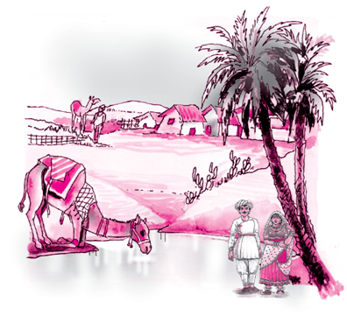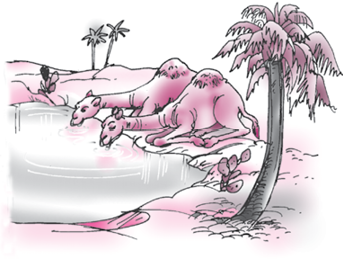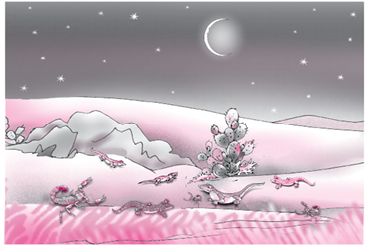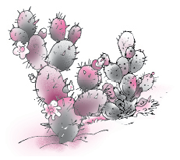Table of Contents
3
The Desert
 A desert is generally without water and vegetation.
A desert is generally without water and vegetation.
 A green patch with fresh water and green trees in the middle of a vast desert is a beautiful sight.
A green patch with fresh water and green trees in the middle of a vast desert is a beautiful sight.
 A desert may be too hot or too cold.
A desert may be too hot or too cold.
Those of us who live in regions covered with forests and surrounded by hills may find it difficult to imagine what a desert is really like. The popular belief is that it is an endless stretch of sand where no rain falls and, therefore, no vegetation grows. It is dry, hot, waterless and without shelter. But this is not entirely correct. For those who have studied it, the desert can be a beautiful place. It is the home of a variety of people, animals and plants that have learnt to live under very hot and dry conditions.
True, the ground is not always hidden by a cover of grass, plants and trees as it is in other climates. But whenever it rains, which is rare, desert flowers bloom and the sight can be as rewarding as that of any tropical garden.
A desert is not always a flat, unchanging wasteland of dry sand. It may have mountains and hills. It may have an oasis, big or small. An oasis is like a green island in the middle of a desert where a spring or a well gives plants and trees a better chance to grow. A desert may be hot like the Thar or cold like Ladakh.
But,generally speaking, if a place has little or no water and vegetation, people usually call it a desert.
regions: areas

Some deserts are almost totally without water. In such places, strong winds blow raising heaps of sand and depositing them as mounds. These are called ‘sand dunes’ that shift and move endlessly across the desert. Few plants can survive on such dry, shifting sands.
mounds: big heaps
Comprehension Check
1. From the first paragraph
(i) pick out two phrases which describe the desert as most people believe it is;
(ii) pick out two phrases which describe the desert as specialists see it.
Which do you think is an apt description, and why?
2. The phrases on the left in the following box occur in the text. Match each of them with a phrase on the right.
(i) an endless stretch of sand fertile place with water and plants in a desert
(ii) waterless and without not visible because the grass shelter is thick
(iii) an oasis nothing but sand as far as one can see
(iv) hidden by a cover of grass no water and no shade
 Desert plants and animals learn to require much less water than most plants and animals.
Desert plants and animals learn to require much less water than most plants and animals.
 The camel is a typical desert animal.
The camel is a typical desert animal.
 Smaller desert animals have unusual means of satisfying their need for water.
Smaller desert animals have unusual means of satisfying their need for water.
All living things need water in order to survive. The few plants and animals that live in deserts have developed the ability to require less water than most plants and animals. The camel, popularly known as the ‘ship of the desert’, can drink a lot of water at one time. Camels can do without water for days together. The reason is they sweat very little. We sweat because we must keep our body temperature constant. We sweat when it gets hot, and this cools the body. Camels can stand high body temperature. They don’t need to sweat and can, therefore, retain the water they drink for long periods of time.


The smaller desert animals do not drink water. They burrow underground during the hot day and come out at night to eat. Some of them eat other animals and get the water they need from the moisture in the meat. Others eat plants and seeds and get the water they need from plant juices.
Desert plants also adapt themselves to the life they lead. Cactus plants store water in their thick stems. Their roots lie close to the surface of the ground and quickly absorb the moisture from the light rains that occasionally fall. The major feature of all deserts is, of course, dryness and variations of temperature. In humid climates, the moisture in the air acts like a blanket and protects the earth’s surface from the hot rays of the sun. The absence of this blanket in desertlands causes the desert to heat up rapidly during the day and to cool off rapidly at night.
burrow: move underground by digging moisture: wetness adapt: change absorb: take in completely
variations: changes humid: containing moisture

Deserts are an important part of nature’s great plan. They are there like the dense forests and the deep oceans. Just because they are hot and dry, one should not look upon them as useless parts of the earth.
Comprehension Check
1. A camel can do without water for days together. What is the reason given in the text?
2. How do the smaller desert animals fulfil their need for water?
3. In a desert the temperature rises during the day and falls rapidly at night. Why?
Exercise
Do the following activities in groups.
1. Describe a desert in your own way. Write a paragraph and read it aloud to your classmates.
2. Go to the library and collect information about the lifestyle of people in desert areas— their food, clothes, work, social customs, etc. Share this information with the group.
